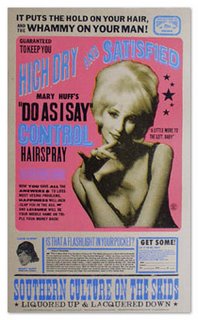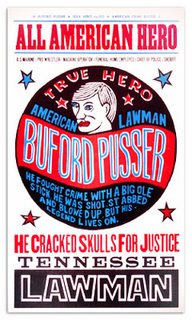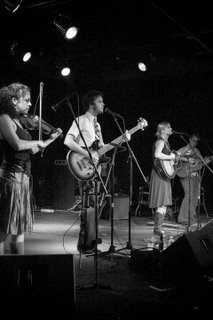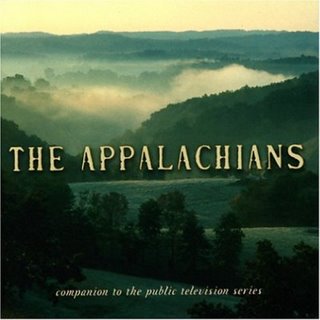You're gonna' want to click on
this first.
There was a man, an steel-driving man, a man named John Henry.

Hell yes there was.
Let me tell you about John Henry. Because he is one of the few heros I have who is, was, or will be, in any shape or form, an idealist. That puts him in elite company, it should be noted, with Jesus of Nazareth, Ghandi, Kungfuzi (Confucius to you
laowai) , Martin Luther King, Jr., and my Mother,
Margaret Gatherum Smith.
John Henry is one of only a very few people
not related to me that I have considered naming a child after - again, putting him in the elite company of George Washington, Benjamin Franklin, Niccolo Machiavelli, and (and this is the one people laugh hard at) Hieronymus Bosch.
You know why I love John Henry? I'll tell you why I love John Henry. Because John Henry did what was right. No, that's not all. Apologies. John Henry did what was right
and what was hard. Hold the boat - that's still incomplete. John Henry did what was right
and what was hard
and what no one believed he could do. Not only all that, but he did it at a time when other men and women believed that he was inferior to their persons. In a country where the ruling elite were trying to say that black men and women were inferior to white men and women, this gentleman set out to demonstrate the essential dignity of
all of humanity.
And he died.
He died and the steamdriver survived to be
used again. And ultimately, well, that automated steamdriver still replaced all of John Henry's peers on the job. Despite his sacrifice. Yessir, John Henry was a simple of inefficiency, of ineconomy, of unreasonable and unwise Luddite romanticism.
John Henry was a damned samurai, riding across the fields of Japan, sword high while automatic rifles and exploding shells tore his comrades and, ultimately, himself apart.
Now, don't take me wrong. I am definitely not a Luddite, nor do I feel that the essential qualities of humanity can or should be justified in terms of our relationship with any machine, nor any other species, nor especially in relation to the Deity. We are us and our value is intrinsic - I feel no need to prove it by being better than anything in nature or by being
publicly close to God or by slowing down the pace of human innovation. But when we devise and scheme and create new technologies and theories and we fail to stop and consider the effects of these technologies and theories on the real people who compose our polities, societies, and economies, especially without preparing both psychological and practical cushioning, we have reactionism, violent rejection of otherwise right and proper advances. Communism, fascism, and religious fundamentalism (Christian, Muslim, Hindu, Jewish, or otherwise), to name a few, are all the products of human beings not only feeling practically displaced, but furthermore feeling essentially displaced, as if by knowing their place in a universe billions of years old, filled with trillions of objects, on a planet overwhelmed by billions of humans, they are less valuable.
John Henry
knew that was bull. Sure, he wasn't a scientist or a philosopher, but he did know that he was a human being - a
free human being - and there is an
intrinsic value in that, no matter how wildly advanced our science, engineering, or philosophy become.
The difference between John Henry and that samurai I mentioned above, as well as many, though by no means all, communists and socialists and radical fundamentalists is this - John Henry never hurt or threatened to hurt other people. John Henry never, ever believed he had the right to sacrifice anyone except himself.
I assume he felt the same about the sacrifice of other people's freedoms, by and large because he knew the costs of that path as well.
Amen.
Well, I've finished my little emotional outpouring. I know I normally write more analytical pieces here, but for John Henry, well, perhaps only sermonizing would do. If you don't know the story of John Henry, well, I have a few links for you. First off, ibiblio, a kind of internet-based public library and database, posts
this site in which the debate between West Virginia's traditional claim to John is compared to Alabama's claim. I'm not a historian, so I won't formally weigh-in on this one, but I will say this - whether or not John Henry lived in West Virginia, I firmly believe his ghost walks there now. So butter your bread with that.
Oh, and for the record - he lived in Summers County, West Virginia. Dammit.
That said, apparently somebody over at
NPR loves and admires ol' John the same way I do -
look at this page. Chock full! Really, seriously, it'll take you awhile. Be prepared.
And, for the comic book guys out there, dig on
this article from the
Richmond Times-Dispatch . . . I don't know if the ol' Prof is right, but I do know that later comics artists, well,
they were inspired.
Also, if you're wondering, yeah, many radical organizations hold up John Henry as a model of the dangers modernization is presenting to the average man in the form of objectification and alienation and so on, and they're not wrong to do so. But if they advocate first-use-of-force violence against others, well, I hope they choke on their slogans. There it is.
PS - That damn fine music I recommend early on in this tirade is by a fellow named John Cephas - I suggest you read
the relevant entry on the C.A.R.T.S. site.



























